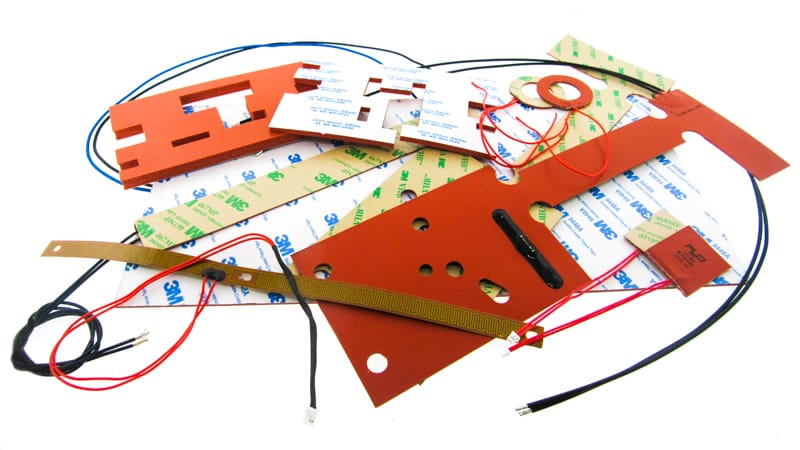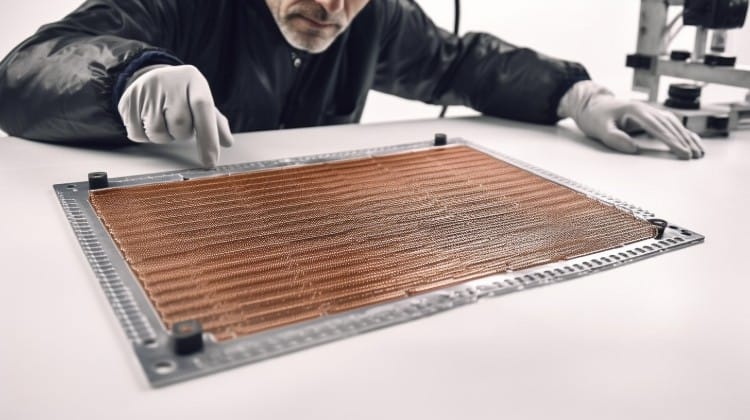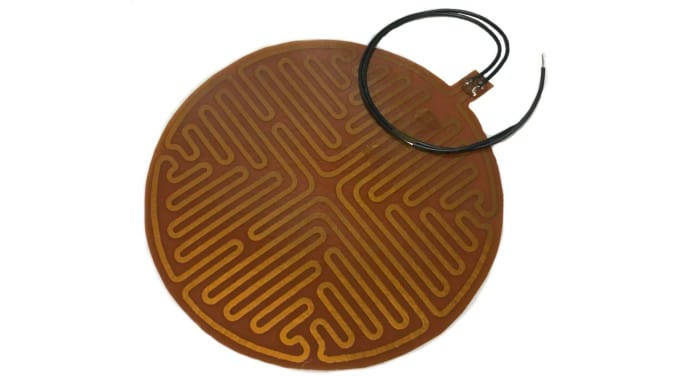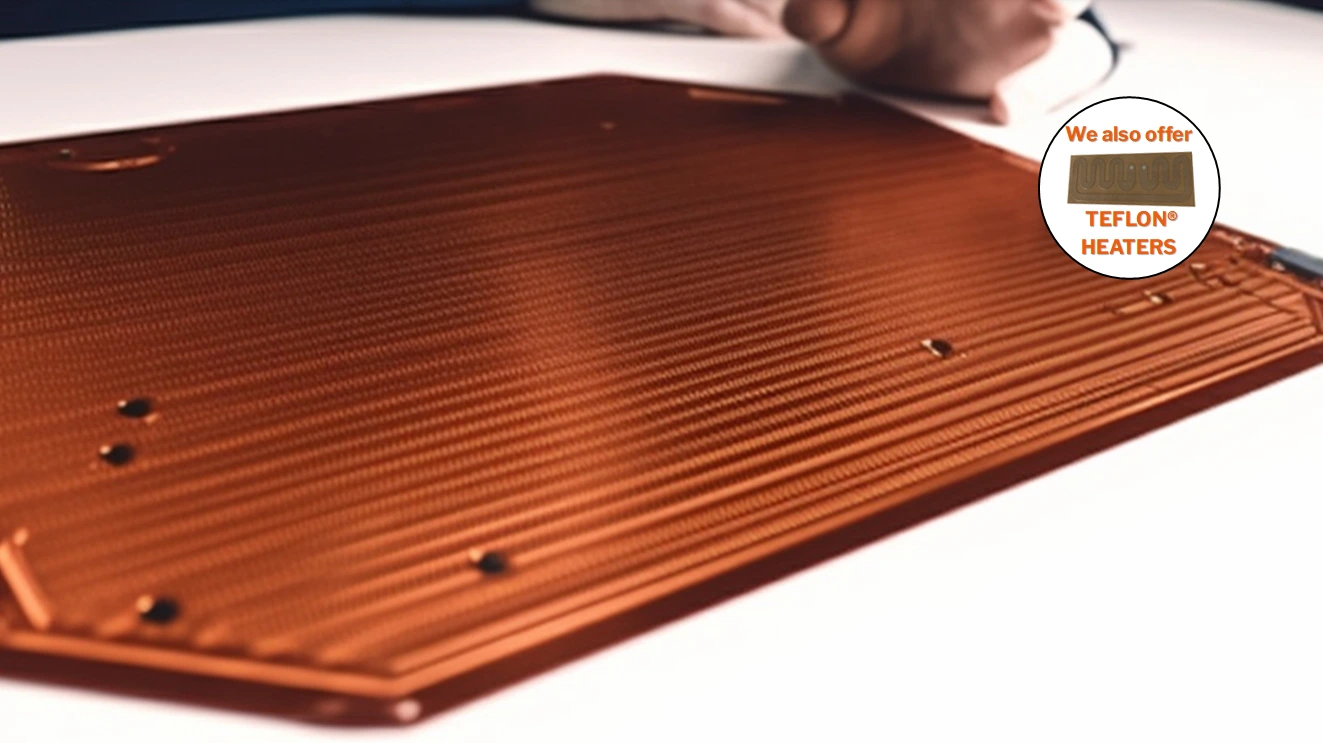In today’s rapidly evolving technological landscape, keeping up with the latest innovations and advancements is crucial. If you are interested in exploring new materials and their applications, you’ve likely come across silicone heaters and Kapton heaters at some point. But have you ever wondered what exactly sets these two apart?

Source
We know both types of heaters are widely used for their flexibility, durability, and high performance – but there’s more to it than meets the eye.
In this article, we’ll dive deep into understanding the fundamental differences between silicone and Kapton heaters so that when you encounter them again, you’ll be well-equipped with invaluable knowledge that sets you apart from them the rest.
Composition And Material Properties

Silicone rubber heater (top) and a polyimide heater (bottom).
When it comes to heater selection, understanding the differences in composition and material properties between silicone and Kapton heaters is essential.
Silicone heaters are made from a combination of fiberglass-reinforced silicone rubber sheets, which provide an even distribution of heat across different surfaces. This type of heater exhibits excellent flexibility, allowing it to conform to various shapes while maintaining its structural integrity. Additionally, silicone has impressive thermal conductivity properties, ensuring efficient heat transfer within the heating element.
On the other hand, Kapton heaters consist of a thin polyimide film that serves as the base for their construction. The heating elements within this polymer film are typically etched or printed using conductive materials such as copper or nickel-chromium alloys. One distinguishing feature of Kapton is its remarkable mechanical strength despite being lightweight and ultra-thin. Consequently, these heaters offer exceptional durability along with high-temperature resistance and superior electrical insulation quality.
Material comparison between silicone and Kapton heaters can be crucial when choosing the right solution for your specific application requirements. While both options deliver reliable performance under varying conditions, they also possess unique characteristics that set them apart.
For instance, silicone’s unmatched flexibility makes it ideal for applications involving irregularly shaped objects or where space constraints demand adaptability. Meanwhile, Kapton stands out due to its low profile design combined with extraordinary temperature tolerances – making it suitable for aerospace, medical devices, or electronics industries where weight reduction and compactness are critical factors.
Ultimately, appreciating these differences will allow you to make an informed decision tailored to your desired innovation outcomes.
Temperature Resistance And Tolerance

Having explored the composition and material properties of silicone and Kapton heaters, we will now delve into a crucial aspect that differentiates these two types of heaters: temperature resistance and tolerance. This factor plays an essential role in determining their suitability for specific applications, as it directly affects performance, reliability, and longevity.
One significant difference between silicone and Kapton heaters lies in their temperature accuracy. Silicone heaters typically offer better temperature uniformity across the heating surface due to the nature of their construction. The wire wound or etched foil elements embedded within the heater provide even heat distribution which is vital for many industrial processes.
On the other hand, Kapton heaters can also maintain good temperature accuracy; however, they may exhibit slight deviations in some cases because of resistance variability caused by changes in ambient conditions or manufacturing tolerances.
When considering high-temperature applications, both silicone and Kapton heaters demonstrate impressive capabilities but have distinct advantages depending on the situation. Silicone rubber heaters are known for their excellent flexibility at lower temperatures while maintaining heat stability up to 450°F (232°C). Meanwhile, Kapton polyimide film excels with its ultra-thin profile and ability to withstand extreme temperatures up to 600°F (315°C), making it ideal for use in aerospace or electronics industries where space constraints are critical.
As technology continues to advance rapidly, designers should carefully evaluate each heater’s unique attributes concerning temperature resistance and tolerance before deciding on the most suitable option for their innovative projects.
Flexibility And Thickness
![]()
One major difference between silicone and Kapton heaters lies in their flexibility and thickness.
Silicone heaters offer flexible installation due to the inherent adaptability of silicon rubber, which makes them suitable for a wide range of applications where uniform heating is required. These heaters can easily conform to different shapes and sizes without compromising performance, providing an innovative solution for those seeking customized heating elements that match their specific needs.
Kapton heaters are also known for offering thinner solutions compared to traditional heater types. This polyimide material boasts a higher strength-to-weight ratio than most other materials, making it ideal for space-constrained settings or lightweight applications where every gram counts.
The thinness of Kapton heaters allows them to be installed almost seamlessly within devices, minimizing any impact on overall design while still delivering efficient heat transfer across surfaces. With this unique combination of characteristics, these heaters have revolutionized various industries by enabling new possibilities in thermal management.
Both silicone and Kapton heaters provide excellent options depending on your application requirements; however, each type offers distinct advantages when it comes to flexibility and thickness. If you’re looking for a versatile and adaptable heating solution capable of handling complex geometries or tight spaces, consider opting for silicone-based products with their innate ability to bend and stretch as needed.
On the other hand, if weight reduction and unobtrusive integration rank high among your priorities, then the ultra-thin profile of Kapton heaters may prove more appealing given its potential to streamline device designs without sacrificing performance levels.
Application Areas And Industries

Both silicone rubber heaters and polyimide (Kapton) heaters have their unique properties that make them suitable for various applications. However, industry adaptability and customization options vary depending on the heater type.
Silicone heaters are known for their durability, flexibility, and resistance to chemicals and moisture. They can operate within a wide temperature range (-60°C to 260°C), making them ideal for use in industries such as food processing, packaging, medical equipment manufacturing, automotive engineering, aerospace technology, among others.
On the other hand, Kapton heaters are lightweight with excellent heat transfer capabilities. These thin-film flexible heaters boast low outgassing properties and high dielectric strength while maintaining a broad operating temperature range (-200°C to 400°C). This makes them perfect for applications where space constraints and weight limitations are critical concerns – often found in electronics manufacturing or vacuum environments.
The versatility of both silicone and Kapton heaters allows manufacturers to customize these products according to specific requirements regarding shape, size, wattage distribution patterns, voltage ratings, integrated sensors or thermostats, lead terminations or connectors – you name it! This level of adaptation paves the way for innovation across numerous fields; no matter your application demands or industry standards required by engineers worldwide.
So whether you need a reliable heating solution designed for harsh environments or looking into reducing overall system weight without compromising performance – there is always an optimal choice available in either silicone rubber or polyimide film-based technologies that cater best to your needs.
Cost And Durability Factors

Cost comparison and durability analysis are essential factors to consider when choosing between silicone and Kapton heaters.
Silicone heaters tend to have a higher initial cost due to the robustness of materials used in their construction. However, they offer longer service life, making them a more cost-effective solution over time for many applications.
On the other hand, Kapton heaters are relatively less expensive initially but may require more frequent replacements due to their lower tolerance towards mechanical stress.
When it comes to durability, silicone heaters possess excellent resistance against chemicals, moisture, and extreme temperatures. They can operate efficiently within a temperature range of -60°C (-76°F) to 230°C (446°F), which allows them to function well under harsh conditions typically found in industrial environments.
Moreover, their flexibility enables seamless integration with complex surfaces without causing damage or compromising performance. Conversely, while Kapton heaters also exhibit good chemical resistance properties and perform effectively in high-vacuum environments, they are more susceptible to cracking or delamination under continuous flexing or vibration.
Taking into account both cost and durability considerations, it becomes apparent that selecting an appropriate heater type ultimately depends on the specific requirements of the application at hand.
For projects demanding extended longevity and resilience against challenging environmental factors like aggressive chemicals or fluctuations in temperature extremes, investing in silicone heaters might be a wise choice from an innovation standpoint.
Alternatively, if the primary concern is achieving optimal heating performance with minimal upfront costs—particularly where constant flexing or vibrations aren’t significant issues—Kapton heaters could present as a viable option worth exploring further.
Conclusion
In conclusion, it’s essential to consider the specific requirements of your application when choosing between silicone and Kapton heaters.
Each material has its unique properties, such as temperature resistance, flexibility, thermal conductivity, and efficiency.
Ultimately, understanding these differences will help you make an informed decision about which heater best suits your needs in terms of cost and durability factors.
Remember that selecting the right heating solution is crucial for optimal performance across various industries and applications.

